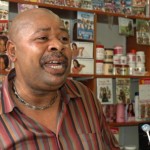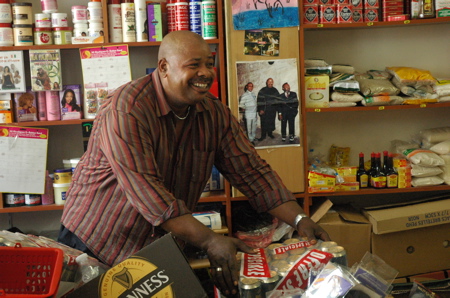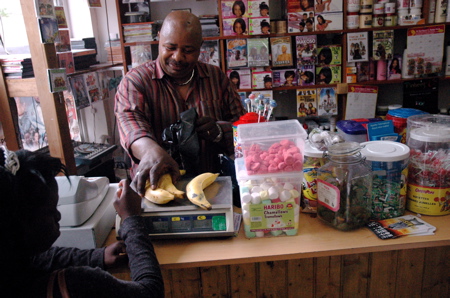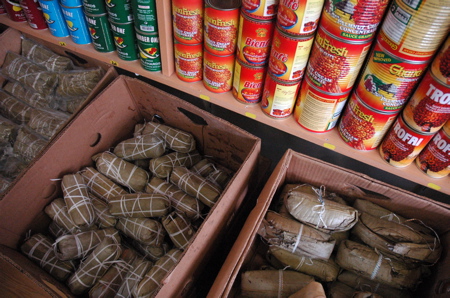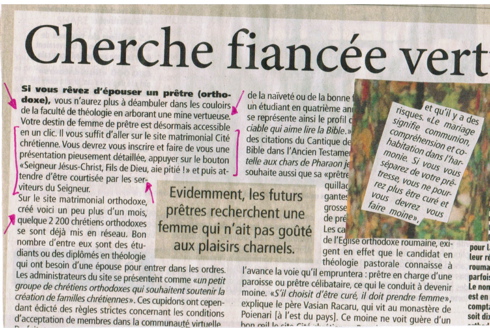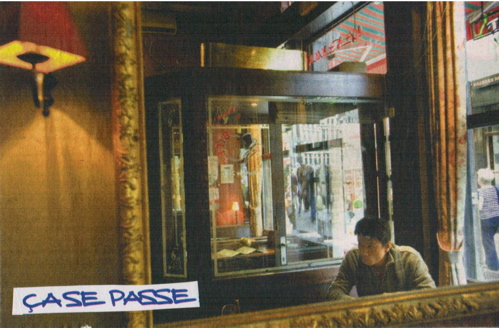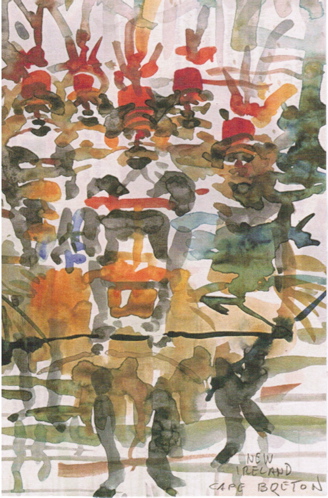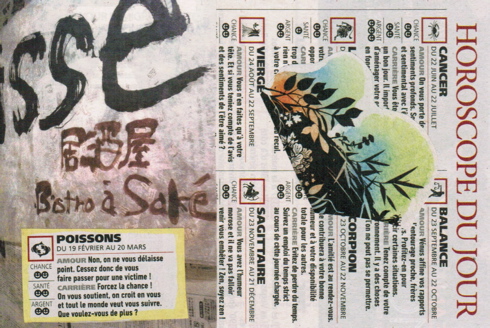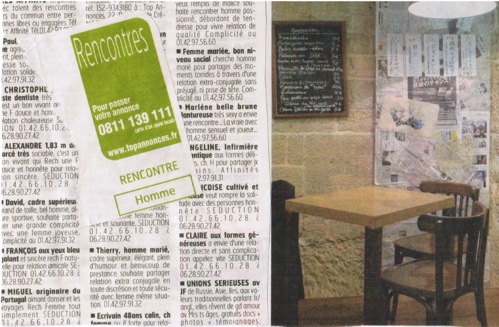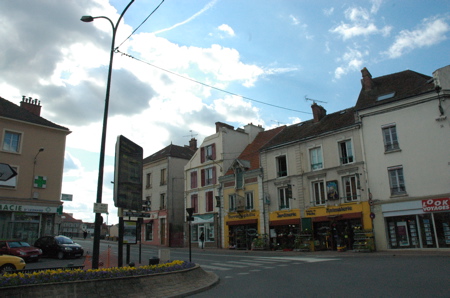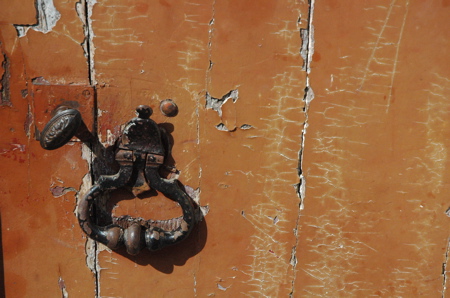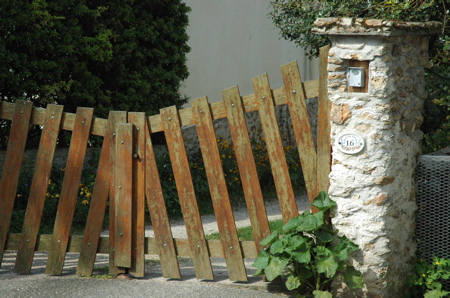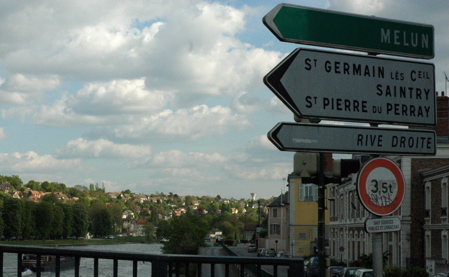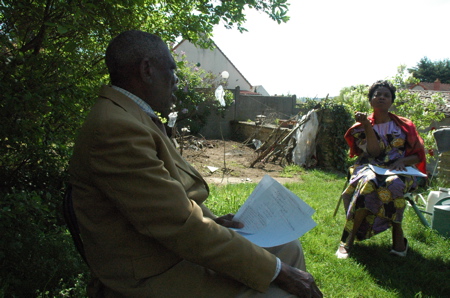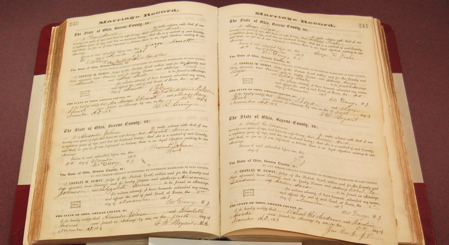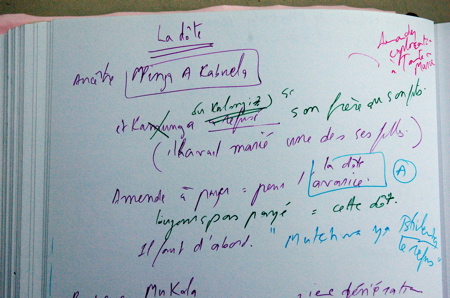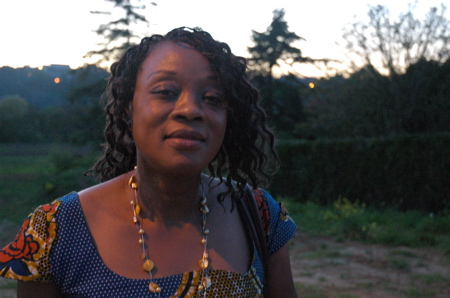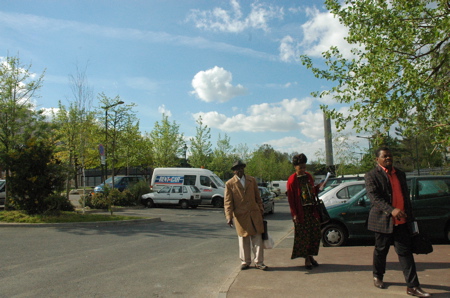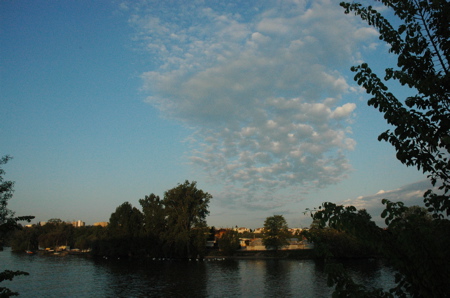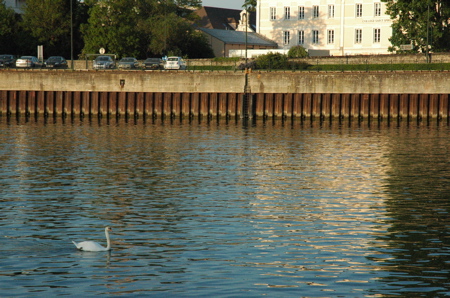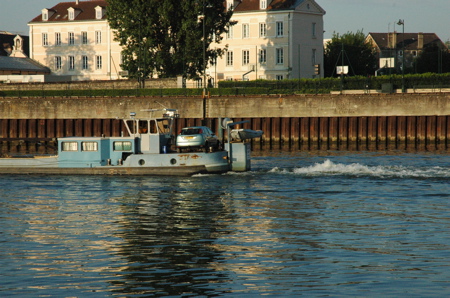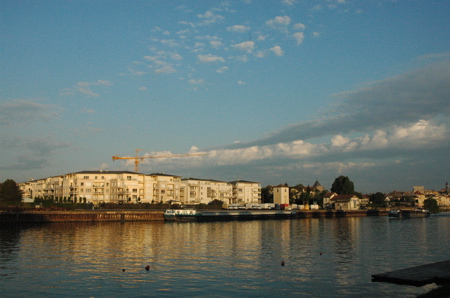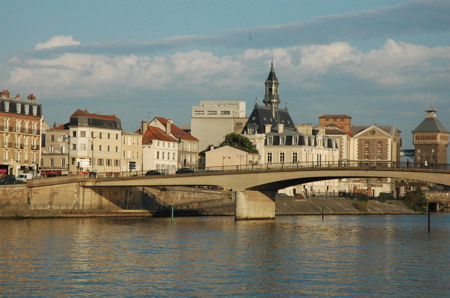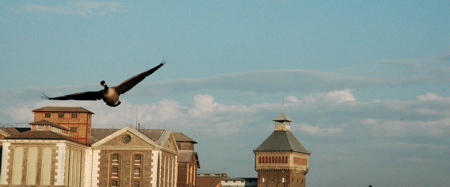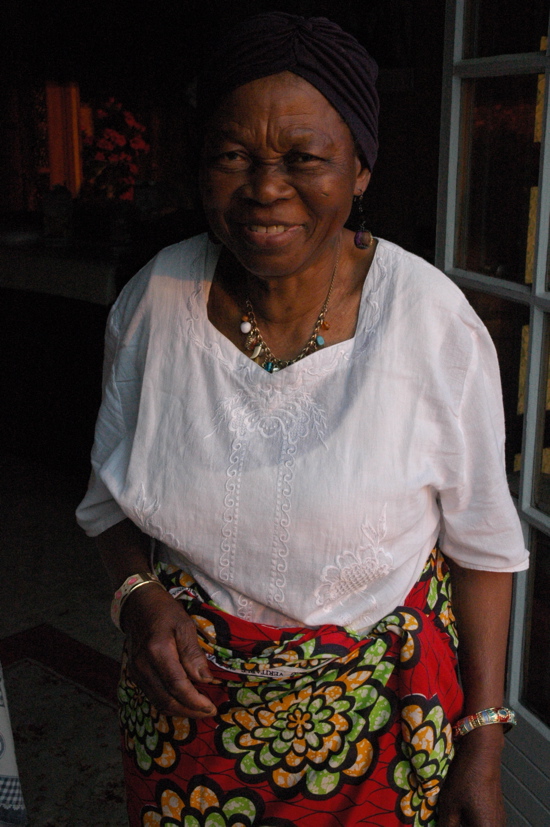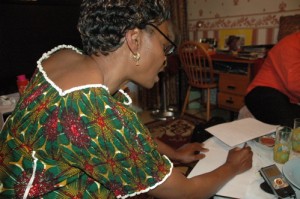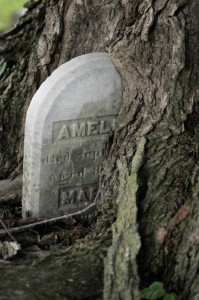6
Jun
During my visit in Chartres, I go to see the only African food store in town, “Exo La Difference”. As I walk in the door, a wave of heat surrounds me. The small fan in a corner is not doing much.
“Charly, it’s hot in here.” a customer says.
“It’s the heat of Africa,” Store owner Charly Musoso replies as if to say that is good for your health.
Sure enough, after a few minutes of sipping cold ginger beer from Jamaica, we all get used to the heat and enjoy the African ambiance. It is Friday afternoon and customers are streaming in.
When people come Chez Charly Musoso, they come for the atmosphere. Tall and heavy set, Charly lifts up cans of beers and restocks the refrigerator all while chatting cheerfully with customers of different nationalities: Congolese, Senegalese, Moroccan, Malian, Indian and so forth. Various African languages can be heard.
“This kwanga, how much?” A customer asks in Lingala, a national language of Congo.
“”2.80 Euros as usual,” Charly replies in the same language.
The only way you know you’re still in France is because the French Open is showing on the television set and the Spanish tennis star Rafael Nadal is playing an hour away from Chartres in Paris.
“For me, this is not just a store,” says Charly, who opened his business more than 10 years ago. “It’s really a cultural center.”
He greets a customer from Madagascar, with whom he often discusses the politics of his client’s country. Charly’s name is on everyone’s lips. It is as if people who walk in are here to visit a friend. The warm hospitality in Charly’s store is what brings the clientele back again and again.
“It’s the way you feel welcome here,” A young woman from Cote d’Ivoire said. “You feel you are here with a brother.”
Charly is helping a customer find a fish. He opens one of the four freezers placed in the middle of the store and digs through freshly frozen fish and salty ones. The other freezers are full of chicken and African and Caribbean vegetables.
The exotic merchandise chez Charly is the other attraction. Kwanga wrapped in banana leaves _ a sort of tough dough made out of cassava flour _ can be found in cartons next to walls of palm oil and sardines. Close by are piles of powder milk cans that remind me of home. It was my favorite drink when I was a little girl. I almost buy one on impulse.
More customers arrive, coming to shop for rice, fish, and yam and also chat with friends before heading home for supper. I reluctantly leave this African hub, but there is more to see in Chartres.
2
Jun
When I ride the métro in Paris, I flip through the readily-available free magazines, “A Nous” and “Métro.”
I sometimes find weird news that send me rolling with laughter. Then I make postcards out of them.
Such is the case with “Cherche fiancee vertueuse,” which literally means “looking for a virtuous fiancee.” It’s a dating service for Eastern European Orthodox would-be priests.
Here are the instructions…
“Open an account, introduce yourself with pious details, click on the button “Lord Jesus Christ, son of god, have pity on us!” then wait to be courted by the servants of the lord.”
Before getting ordained, Orthodox theology students have to be married. If not, they become monks.
Hence, the rush.
Enjoy the homemade postcards and have a great weekend!
Kabuika
http://kabuikakamunga.com
Above is a postcard I made out of an ad found in one of those free daily papers one can pick up at any metro station in Paris. The central ad reads,
“Thierry, married man. Elegant executive with humor, fit to be seen, wishes to engage in extra-marital relationship in all discretion and security with woman in similar situation.”
The ad ends with a phone number, not a cell phone number, but a landline telephone number!
That’s kind of shocking since the ad is placed in a Western society where monogamy is the rule.
I recently asked the patriarch of my family why so many Baluba men have multiple wives. He replied, it is so they would not go looking for other women elsewhere.
His answer surprised me since I had expected Luba polygamy to exist for the purpose of engendering as many children as possible. Children are the primary reason for polygamy, my uncle admitted. A reader had guessed well, regarding the story “Multiple Wives.”
Luba men are polygamous in order to have a lot of kids, who will later care for them as they grow old. So yes, it is a form of social security system.
However, the Luba society allows men to marry several wives for a second very good reason.
“Men are going to run after many different women anyway,” my uncle said.
Personally, I don’t believe that all men (Luba or not) are all womanizers. My uncle himself has only had one woman for 60 years.
The patriarch carried on. Luba men are encouraged to make those relationships legal and public, One. So that there could be no illegitimate children. Two. So that those men would be fully involved in the lives of their several wives. This was a good way to keep them busy and decrease the likelihood of them wandering in the street looking for more.
So here is an idea.
If French men start to marry let’s say two or three women, they would be so occupied with their wives that they won’t have time for any extra-marital affairs.
You see, the Luba resolution could potentially be used to solve the French quandary.
1
Jun
I know I am in France, because everywhere I look I see beauty.
This was my first impression when I took my first walk in the town of Saintry sur Seine. It still is.
A 60-year-old-looking Frenchman is sweeping his wooden gate as I walk by.
“It has to be clean.” He tells me with a shrug and a smile.
I smile back. The Frenchman seems to have come out of a postcard. All he needs is a beret.
Everything in France is old and charming. You can feel the centuries of stories in every nook and stone. I admire the old wooden door with its rough iron handle.
Gates here could be the subject of an entire photography book. They are all so different and original.
French people have a particular eye for beauty. In early April, the purple-scented flowers showered me with their perfume as I walk underneath them on the sidewalks. The following month, the town is now decorated with potted flowers at every window, framed with wooden shutters.
For me France is a guide post in this stage of my new life, pointing in the direction I choose to take. And because these sign posts are French, they do so with charming details, on a backdrop of the river Seine.
31
May
Five hours! Five hours I spent with my uncle Tshimanga, learning about one thing and one thing only: the dowry.
“It’s the cement!” My uncle repeated. “The cement that binds all the members of the family together. With the dowry system, everyone in the family gets a chance to marry. And so the family continues to grow and is strengthened.”
The dowry _ “la dote” in French _ is the base of an informal barter system created within our family. This swapping strategy acknowledges that everyone in the family has the right to get married no matter what their economic status is.
My uncle used to have the family dowry book. He lost it in his move to France more than a decade ago. Fortunately, he knows all the dowries by heart: the ones given by our family and the ones received.
I imagine the family book was written like an accounting book, keeping track of all dowry transactions. The book must have been filled with the “who’s who” of all our family marriages.
Following all this was very important, you see, since the person who helps you marry is in fact the one who shells out the dowry money for you to be able to get married. It’s like giving out a bank loan.
Since the Luba society is patriarchal, it is the men who marry the women; so they are the ones who pay the dowry to the women’s families.
My father, for example, helped his younger brother (Uncle O) get married: He paid for his dowry. Thanks to my Dad, my uncle O was able to start his own family and have children. A few years ago, Uncle O’s oldest daughter got married (her husband paid a dowry for her). That dowry was used to reimburse my Dad.
I imagine, the family ledger of these dowry transactions to look like this:
DOWRY BOOK:
Papa —> pays —> : Uncle O. marries (in 1975)
: Dowry = 1,200 FC (Congolese francs) [Out flow of cash]
Uncle O’s daughter gets married (in 2000)
<— : Dowry received = $500 (US dollars) [In flow of cash]
Papa gets reimbursed receiving $500.
I don’t know what 1,200 FC would amount to, but remember the amount of each dowry does not matter. What counts is one dowry reimbursing the other.
My paternal grand-father was the mastermind behind this dowry system. He wanted to make sure that after he passed away, his older sons will be able to help his younger ones get married. The dowry organization he created goes in even greater details, planning for all possibilities.
Even if the older sons do not have enough money to help out, it’s the dowry of their second daughters that will be used to help their younger siblings get married. Once again, I am using my Dad as an example.
Papa’s second daughter (my sister) got married. He received her dowry, turned around and used it to help his younger brother (Uncle M.) get married.
And so in the far, far future when my niece, who is about 5 years old now, gets married, my Dad will get reimbursed. Her future dowry will pay back the dowry debt that helped her father get married and bring her to the world.
Dowry debts are never forgotten!
If a dowry is not reimbursed within the lifetime of a donor, his brothers _ representing him _ will get compensated. If none of his siblings are alive, then his descendants will get reimbursed.
There is such a dowry debt in my family that has lasted for 5 generations. It is finally about to be paid.
30
May
So you have fallen in love with a Luba woman and asked her to marry you. Contrary to Western norms, this is only the beginning of a long journey to marriage.
STEP #1: You need to introduce yourself officially to your girlfriend’s parents. Avoid going alone.
I still remember my sister’s boyfriend coming to introduce himself. He came to our house _ alone _ with my sister hanging on his arm, very much in love. The boyfriend was not wearing a suit, but was rather dressed as if he was going to a party: flashy shirt and pants, topped with pink glasses shaped as hearts. I knew right away this was not going to be a good introduction. I was right. My Dad arrived, took one look at the scene, barked “What is going on here?” and threw the young man out of the house.
To show up alone at our house signaled to my Dad that this man was not taking himself seriously, nor respecting our family. For Luba people, marriage is a serious matter; it is a contract not only between two individuals, but also between their two families. So a suitor must come with his parents and siblings to ask for the girl’s hand. My sister’s boyfriend had to re-introduce himself properly _ this time with his family members.
THE UNOFFICIAL STEP #2: Expect to get investigated.
The Luba investigation has to do with integrity. Both families will likely do a background check on each other to see if the man (or the woman) is indeed what he portrays himself to be and that there are no skeletons in his closet.
Paranoid, you think?
My family started to ask around about my sister’s boyfriend: his job, his habits, who was his family? Where did they all go to school … everything. It turned out the man was separated, but still legally married to his wife AND he had children; details he had failed to mention to my sister. Thanks to this investigation, my sister had all the facts laid out in front of her and was now free to make a decision with more clarity.
STEP #3: The Dowry.
You have survived the investigation and are still considered marriage quality. Congratulations! Now we can proceed.
It doesn’t matter whether you are American or French, whether this is the 21st century or the 19th. When it comes to marrying a Luba woman, you can only do so the Luba way _ with a dowry.
The dowry has several objectives, but for the sake of this article, we will focus on one meaning. “La dote,” as it is called in French, is a marriage contract, the symbol of agreement between two families.
The dowry can range from 50 cents to more than 1000 euros. Before modern money, the dowry was paid in Luba currency of copper crosses. The girl’s family determines the amount, which in itself is not important. It is the token of the dowry, changing hands from one family to the other, that is crucial.
If you accomplish all these steps, you will be well on your way to winning the hearts of your future Luba in-laws.
I have left out a few details, goats and such… but you’ll find out later.
29
May
It’s Sunday morning. I decide to watch the sunrise. The town I live in, Saintry sur Seine, is exactly what its name says, “Saintry on the river Seine.” The river Seine snakes through Paris and its banlieues. Being on La Seine means being in the valley. On either side of the river, hills ascend in the east and in the west. It will take some time for the sun to rise from above the hill and shine its rays on the small town. Perfect! That means an extra hour in bed for me before going out to shoot the sunrise.
After an early breakfast of baguette and hot chocolate, I’m on the road. The city is still asleep as I walk along La Seine. There are no cars, no early-bird construction workers, only the occasional homeless men asking for a cigarette. It feels like the sun is putting on a show for only me and the swan.
The swan glide silently on La Seine letting me take their portraits. I continue walking, my sandals crunching the black gravel. My steps harmonize like music as they combine with the ”Cock-a-doodle-doooo” of a nearby chicken, except that French chickens say “cocorico.”
Soon the motor sound of a barge breaks the tranquil morning. A blue barge, complete with a car on top, churns down the river.
I wonder what it is like to live on a barge? It is a common way of life in France. A barge (called peniche in French) sometimes carries a car for its owner to zoom to work every morning, I imagine. Barges here even have mailboxes on the river banks for the mailman to bring letters and packages to the river people.
I walk for about an hour and reach the next city called Corbeil.
In Corbeil, my sunrise walk ends with a view of la Mairie (city hall) and a bird flying over the city, waking up.
This weekend I will be resting for Shabbat as usual. Afterward I will interview my Aunt Malu (seen in the picture above).
There is one minor detail to this plan: my aunt doesn’t speak French. And I barely know any Tshiluba.
No worries, I tell myself, this issue will only spice up our conversation.
I look up some synonyms of ’spice up’ on Thesaurus.com:
“animate, brace up, brighten, divert, entertain, excite, fire up, galvanize, give life to, invigorate, jazz up, juice up, quicken, spark, stimulate, vivificate, vivify, wake up, zap.”
Yep! I can visualize the interview already.
Thank you for reading my stories. Your comments and emails are very much appreciated. Feel free to contact me on my website by filling out the contact form: http://kabuikakamunga.com.
See you next week with new stories of my travels, including “If you want to die quickly, sleep with a Luba woman.”
When it comes to methodology, genealogists say there are three ways of gathering information: find documents in family homes, interview parents, and visit cemeteries.
Now let’s look at this from a Congolese perspective.
Method #1. Find documents such as birth certificates.
That’s only possible when the family is living in the West. If you ask someone in the Congo to send you a copy of a birth certificate, you could wait a while, a long while.
I have a cousin in Europe, who requested a copy of his birth certificate from Kinshasa. He had to wait 6 months to receive it. And when the document arrived, the place of birth was wrong. It said he was born in Kinshasa, instead of Lubumbashi. Not wanting any further delays, he did not request another one. So now in his immigration status in Europe, he officially was born in Kinshasa.
This would be alright … if he didn’t have a twin sister.
Place of birth of my cousin: Kinshasa
Place of birth of my cousin’s twin sister: Lubumbashi
Welcome to my genealogy world!
Method #2. Interview parents, grand-parents, uncles, aunts, and anyone you can get hold of.
This we can do! That’s about the only sure thing we can do in African genealogy since we have a strong oral history culture. In our large families, elders are the guardians of collective memories and are eager to pass on the knowledge to the next generations.
In Paris, I am immersed in oral history. Knowledge is given though stories colored with humor, laughter and the storyteller’s personal snazziness. Read any of my earlier blog entries and you’ll get a taste of it.
Method #3. Visit family tombstones to find names and dates of birth and death.
That works only in well-kept cemeteries like in the West (or even in Morocco). When you die in Kinshasa, you have a chance to be “found” if you get buried in an expensive cemetery, maybe alongside diamond businessmen and powerful politicians. I remember my mother trying to find her father’s tomb a few months only after he passed away. She came back from the cemetery laughing. She never could find it. Overgrown vegetation had taken over the graves.
So do you think that the next time I am in Kinshasa I will find my grand-father’s tomb? Not a chance!
Sitting with my uncle on a Sunday afternoon, I ask him how he got married. My aunt and him had recently celebrated their 60th wedding anniversary. His face lits up and he says:
“We got married on a Wednesday.”
O.k.! So back in the days, people got married on Wednesdays and today many Christian weddings occur on Saturdays. No big deal.
No, my uncle explains, Saturday weddings were called “Les mariages a Njiji,” the weddings of flies, of insects. People who got married on Saturdays were not virgins. These were people who lived together and even had children already.
So if you were virgin (especially the woman), you got married with dignity on Wednesday and the bride got to wear a white veil. We are talking about a religious wedding here; so even in the 1950s, religious weddings in the Congo looked very much like any weddings in the West.
While a white veil and a Wednesday wedding were the Christian rewards for virginity, among the Baluba (particularly the Bakwa Dishi people), you get a goat. Not just any goat! It’s the “Mbuji Wa Nyima,” the goat that is given after the wedding.
Here is how it works. Soon after the consummation of marriage (which determines with certainty that the woman was indeed virgin), the husband has to bring a goat to the woman’s family to thank them for having raised their daughter well.
Now, you see, my Mom was both a Christian and a Mukwa Dishi. She had her Wednesday wedding with a white veil in a Catholic church in Liege, Belgium where my Dad was studying medicine. Since they were in Europe, my Dad decided they would wait until they returned to the Congo to bring a goat to her family.
Years passed by and two children later, my Dad kind of forgot about that obligation, until my Mom suddenly shouted,
“And where is my goat?”
My Dad with all his medical degrees and high social status, had to go back to my Mom’s village and present the goat to her family as a thank you.

